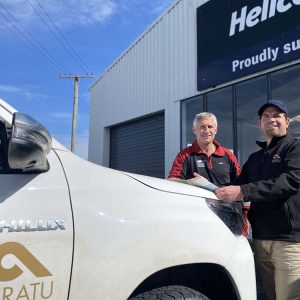Helicopter pilot Mike Fitzgerald recalls flying to a tractor rollover up the East Coast, which required a hover-offload on a hillside.
“That meant we could drop the critical care flight paramedic right where he was needed, along with a Fire Emergency New Zealand staffer with essential airbag lifting equipment,” says Mr Fitzgerald, one of three pilots flying the Trust Tairāwhiti Eastland Rescue Helicopter.
“It’s a fairly routine manoeuvre but you need to practise it with a full crew so everyone knows what they need to do.”
Training is a critical part of rescue helicopter work and, for that, the crews need suitable territory, he says.
“Finding somewhere to fly over and hone techniques sounds simple but it can be quite complicated. We need terrain suitable for things like winch training and skid landings; we need to consider the surrounding neighbours, especially for night training; and we need to be close to home so we can respond quickly if we get a call.”
In recent years much of the Eastland crew’s training has been done at Waipura Farm, Matt Maclaurin’s property at Back Ormond Road, Gisborne.
“That’s been an incredible resource for us but we don’t want to overuse it and outstay our welcome, especially at busy times like lambing,” Mr Fitzgerald says.
“We’re just grateful Matt has allowed us to use it for so long, and to continue to use it into the future to give us a variety of training options.”
The new training ground is at Aratu Forests’ property Waimanu Forest which, though a long way down Riverside Road by car, is just a few minutes flying time from Gisborne Airport, home of the Eastland Helicopter Rescue Trust hangar.
And while securing the site involves a lot of Health and Safety-related paperwork, Aratu cyclone recovery manager Richard Powell believes it is worth the effort.
As a former police officer Mr Powell has been involved in his fair share of searches, accidents and emergencies where he has seen the rescue helicopter in action.
“Their involvement is often the best option for a good outcome, whatever that may look like,” he says.
“Our chief executive, Neil Woods, is always keen to help the community so supporting the work of our awesome rescue helicopter was a no-brainer.”
The forestry industry, too, had benefited from the work of the rescue helicopter so offering additional training space was a win-win for everyone, Mr Powell added.
“Plus, we know how safety-conscious the Eastland team is, and how rigorous their policies are, so we’ve worked through all the details without any problems.”
As with all rescue helicopter teams, the Gisborne pilots, crewmen and critical care flight paramedics all have training “currencies” that need to be updated regularly.
On any given training mission they cover techniques from confined or slope landings and hover off-loads and pick-ups, to winch training and night work.
“To do that effectively we need different terrain available to us, and we need to be able to stagger those training periods to ensure each and every crew member is up to date,” Mike Fitzgerald says.
“That’s especially important right now as we have new crew on board and that creates big demands on training time.
“As well as sharpening their skills we build understanding between the team as a whole, which is critical to working efficiently in an emergency setting.”
TEAM WORK: Trust Tairāwhiti Eastland Rescue Helicopter pilot Mike Fitzgerald (left) and Aratu Forests cyclone recovery manager, Richard Powell, have worked together to secure new training territory for the team’s pilots, crewmen and critical care flight paramedics.
